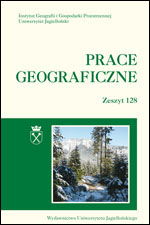Zmiany granicy rolno-leśnej w Pasmach Magurskich Beskidu Niskiego od lat 1978-1980 do lat 2003-2004
Transformation of the forest-field boundary in the Pasma Magurskie (Beskid Niski Mts) from 1978–1980 to 2003–2004
Author(s): Agnieszka NowakSubject(s): Cultural Essay, Political Essay, Societal Essay
Published by: Wydawnictwo Uniwersytetu Jagiellońskiego
Keywords: forest-field boundary; changes; landscape; reforestation
Summary/Abstract: Beskid Niski is the region of Polish Carpathians, where the most significant changes in population took place. The depopulation started during the Second World War and continued until 1947, when the Lemkos were displaced from the region, which caused the abandonment of their farms and began the renaturalization process. Those changes as well as political and economic changes in Poland since 1990 are the factors which influenced pattern of the forest-field boundary in the discussed area. The author’s research was carried out in the Pasma Magurskie region, which is in the central part of Beskid Niski Mts. in Outer Western Carpathians (Fig. 1). The study area included also the Magura National Park. The main tectonic unit here is the Magura Nappe. The relief of Pasma Magurskie was formed by fluvial and denudation processes. As for altitudinal zonation, two vertical zones are distinguished here – the foothill vertical zone where original Tilio-Carpinetum betuli was transformed into agricultural fields, and lower forest vertical zone covered with Dentario glandulosae-Fagetum. As a consequence of depopulation settlement density is low here in comparison with other parts of Polish Carpathians. The author’s aim was to investigate changes in the geometry of forest-field boundary and its altitude between 1978 and 2004 in the Pasma Magurskie. Additionally, changes in the forest area were examined. The research was based on the map overlapping technique. Data derived from digitized topographic maps made in the 1978–1980 period and orthophotos of 2003–2004 years were compared and changes were analyzed. The total forest area in the region increased from 69,4% in 1980 to 73,2% in 2004 (tab. 1). At the same time the altitude of forest-field boundary lowered by c. 18 m. Also the values of metrics concerning fragmentation of forest patches increased considerably (tab. 4). It means that the process of reforestation, which through temporal fragmentation leads to the merger of landscape, is continued.
Journal: Prace Geograficzne
- Issue Year: 2011
- Issue No: 128
- Page Range: 111-126
- Page Count: 15
- Language: Polish

